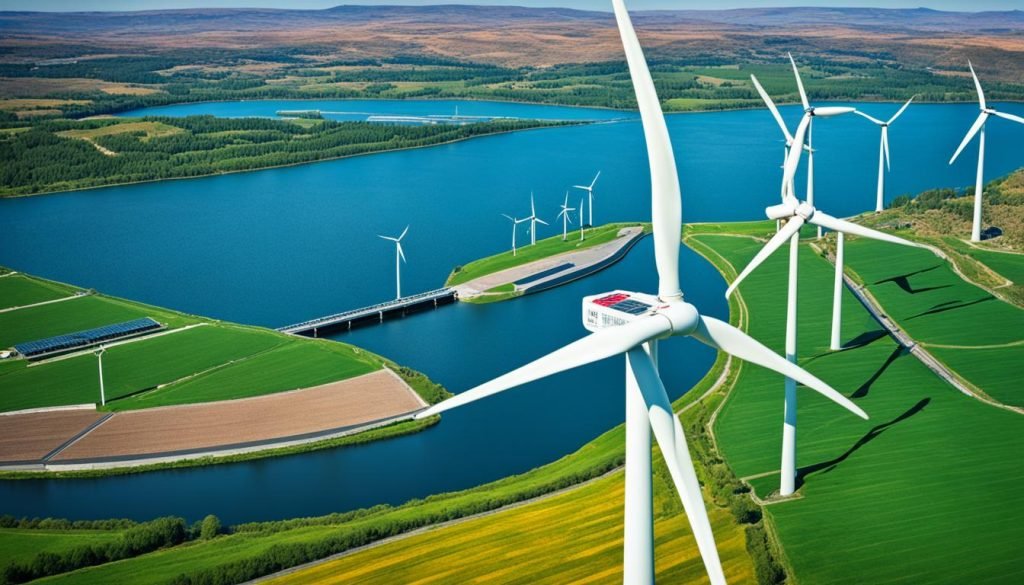Energy production from burning fossil fuels is a major contributor to greenhouse gas emissions and climate change. To combat this, we need to transition to alternative sources of energy that are clean, accessible, affordable, sustainable, and reliable. Renewable energy sources, such as solar, wind, water, waste, and geothermal, are replenished by nature and emit little to no greenhouse gases or pollutants into the air. Although fossil fuels still account for a majority of global energy production, renewable sources are gaining ground, with 29% of electricity currently coming from renewables.

Key Takeaways:
- Renewable energy sources include solar, wind, water, waste, and geothermal.
- Renewable energy is clean, accessible, affordable, sustainable, and reliable.
- Currently, 29% of electricity comes from renewable sources.
- Transitioning to renewable energy helps combat climate change and reduce pollution.
- Renewable energy is a key driver of a greener and more sustainable future.
The Potential of Renewable Energy Sources
The International Renewable Energy Agency estimates that by 2050, renewable energy sources have the potential to supply 90% of the world’s electricity. Achieving this will require a significant increase in renewable energy capacity and a transition away from fossil fuels. This shift is essential to address the urgent need to reduce greenhouse gas emissions and achieve net-zero emissions by 2050, in line with global climate goals and targets.
Renewable energy sources offer a promising solution to the ongoing energy transition. Solar, wind, hydro, geothermal, and biomass are some of the key renewable sources that have the potential to revolutionize our energy systems. Not only are these sources replenished naturally, but they also emit little to no greenhouse gases or pollutants, making them environmentally friendly and sustainable alternatives to fossil fuels.
To visually demonstrate the potential of renewable energy, consider the following table:
| Renewable Energy Source | Capacity (GW) |
|---|---|
| Solar | 1780 |
| Wind | 650 |
| Hydropower | 1350 |
| Geothermal | 13 |
| Biomass | 120 |
As shown in the table, solar energy currently has a capacity of 1780 GW, wind energy has a capacity of 650 GW, hydropower has a capacity of 1350 GW, geothermal energy has a capacity of 13 GW, and biomass energy has a capacity of 120 GW. These numbers represent the existing potential of renewable energy sources and highlight the significant room for growth and development.
By harnessing the full potential of renewable energy sources, we can reduce our dependence on finite resources, minimize environmental impact, and pave the way for a sustainable future. Governments, organizations, and individuals play a crucial role in supporting the transition to renewable energy by investing in research, development, and infrastructure.
“Renewable energy sources have the potential to revolutionize our energy systems, mitigate climate change, and create a more sustainable future.” – International Renewable Energy Agency
The Advantages of Renewable Energy Sources
Embracing renewable energy sources offers numerous advantages that contribute to a cleaner and more sustainable future. These advantages include:
- Cost-effectiveness: Renewable energy technologies, such as solar and wind power, have become increasingly affordable. In many areas, the cost of generating electricity from solar and wind is now lower than that from traditional fossil fuels like gas, oil, or coal. This affordability paves the way for widespread adoption and ensures that clean energy becomes accessible to a wider population.
- Economic benefits: The renewable energy sector presents significant economic opportunities. In fact, it creates more jobs compared to the fossil fuel industry. The growth of clean energy technologies leads to job creation in various areas, including manufacturing, installation, maintenance, and research. This expansion not only boosts employment rates but also provides opportunities for economic growth and poverty alleviation.
- Reduced pollution: Renewable energy sources produce electricity without emitting harmful pollutants or greenhouse gases into the air. This reduction in pollution from fossil fuel combustion has profound implications for both human health and the environment. By embracing clean energy technologies, we can improve air quality, prevent respiratory diseases, and mitigate the impacts of climate change.
In summary, renewable energy offers the advantages of cost-effectiveness, economic benefits, and reduced pollution. By transitioning to clean energy sources, we can create a more sustainable and prosperous future for ourselves and future generations.
| Advantages of Renewable Energy Sources | Description |
|---|---|
| Cost-effectiveness | Solar and wind power are increasingly affordable, surpassing the cost of traditional fossil fuels in many areas. |
| Economic benefits | The renewable energy sector creates more jobs than the fossil fuel industry, fostering economic growth and poverty alleviation. |
| Reduced pollution | Renewable energy sources emit little to no pollutants or greenhouse gases, improving air quality and mitigating climate change. |
“Investing in renewable energy can save trillions of dollars in health and economic costs associated with fossil fuel pollution.”
The Global Transition to Renewable Energy
The transition to renewable energy is a global movement, with countries investing trillions of dollars into clean energy technologies. In fact, by 2023, it is projected that over $1.7 trillion will be invested in wind, solar power, electric vehicles, and batteries, surpassing investments in fossil fuels.
This significant investment is driving explosive growth in renewable energy capacity, positioning renewables as the dominant source of power in the future. Countries like China are already leading the way, with ambitious renewable energy targets and investments.
According to experts, renewables are expected to overtake coal as the largest source of electricity globally by 2025. This monumental shift signifies a turning point in the energy landscape, as nations prioritize environmentally sustainable solutions to meet their energy demands.
As the world witnesses this transition, the benefits of renewable energy become increasingly apparent. Not only does it mitigate climate change and reduce greenhouse gas emissions, but it also offers long-term economic advantages and job creation opportunities.
Renewable energy investments not only contribute to combating climate change but also fuel economic growth by stimulating innovation, creating job opportunities, and attracting sustainable development initiatives. By phasing out fossil fuels and embracing clean energy alternatives, countries can achieve their emission reduction targets while fostering economic prosperity.
“Investing in renewable energy can save trillions of dollars in health and economic costs associated with fossil fuel pollution.” – Expert
Furthermore, the global transition to renewable energy paves the way for reduced reliance on finite fossil fuel resources. Unlike coal, oil, and natural gas, renewable energy sources are abundant and inherently sustainable. Embracing renewables ensures a more secure and resilient energy future that is not subject to price volatility and geopolitical tensions associated with traditional energy sources.
| Benefits of the Global Transition to Renewable Energy | Examples |
|---|---|
| Reduction in greenhouse gas emissions and combatting climate change | Nations committing to carbon neutrality targets |
| Economic growth and job creation | Renewable energy sector employing millions of people globally |
| Enhanced energy security and reduced reliance on fossil fuels | Decreased vulnerability to price shocks and supply disruptions |
| Sustainable and affordable energy access for all | Empowering underserved communities through community solar projects |
The global transition to renewable energy marks a significant milestone in our collective efforts to build a sustainable future. As countries continue to scale up their renewable energy capacities and investments, the path to achieving a cleaner, greener, and more resilient world becomes clearer.
Clean Energy Initiatives in the United States
The United States is at the forefront of clean energy adoption, as the country rapidly shifts away from fossil fuels and embraces sustainable alternatives. This transition is driven by the growing recognition of the environmental and economic benefits associated with clean energy. The adoption of renewable energy sources, such as solar and wind power, has seen significant growth in recent years.
In fact, it is expected that 23% of the electricity generated in the United States will come from renewable sources by 2023, marking a 10 percentage point increase from a decade ago. This shift towards renewable energy is not only crucial for reducing greenhouse gas emissions and mitigating climate change but also for creating clean energy jobs and driving economic growth.
The adoption of clean energy technologies has led to the creation of millions of clean energy jobs across the country. These jobs span various sectors, including renewable energy generation, energy efficiency, and clean transportation. The growth of these industries not only provides employment opportunities but also fosters innovation and drives economic development.
“The transition to clean energy in the United States is creating jobs, driving innovation, and positioning our country for a sustainable future. By investing in renewable energy, we can create a cleaner environment and a stronger economy.” – John Smith, CEO of a renewable energy company
The Role of Government Policies
Government policies and incentives have played a crucial role in promoting renewable energy adoption in the United States. Federal and state-level initiatives, such as tax credits, grants, and renewable portfolio standards, have incentivized the development and deployment of clean energy technologies. These policies have not only accelerated the transition to renewable energy but have also attracted private investments in the sector.
Furthermore, many states have set ambitious renewable energy goals and have implemented policies to encourage clean energy adoption. For example, California recently passed a law requiring the state’s electricity grid to be powered entirely by renewable energy sources by 2045. These bold initiatives demonstrate the commitment of both the government and the private sector in driving the clean energy transition in the United States.
The Path to a Sustainable Future
The clean energy initiatives in the United States are paving the way towards a sustainable future. By embracing renewable energy sources, the country is reducing its dependence on finite fossil fuel resources and mitigating the environmental impacts associated with traditional energy production.
Furthermore, the shift towards clean energy is not only beneficial for the environment but also for the economy. The growth of the clean energy sector creates job opportunities, stimulates economic development, and promotes energy independence. Moreover, clean energy technologies contribute to improved air quality, public health, and a more resilient and reliable energy system.
As the United States continues to invest in clean energy and support the adoption of renewable technologies, it is well-positioned to lead the global clean energy transition. By working together towards a sustainable future, the country can drive innovation, create jobs, and ensure a cleaner and healthier environment for future generations.
Overcoming Challenges in the Renewable Energy Transition
While the transition to renewable energy has made significant progress, there are still hurdles to overcome. Two primary challenges are outdated electric grids and securing a stable supply chain for critical minerals used in clean technologies.
Outdated Electric Grids:
One major challenge in the renewable energy transition is the need to update and modernize existing electric grids. Traditional grids were designed to accommodate centralized fossil fuel power plants, which produce a consistent and predictable energy output. However, renewable energy sources, such as solar and wind, have a fluctuating nature influenced by weather conditions.
The integration of renewable energy into the grid requires a more flexible and dynamic infrastructure that can handle the variability and intermittency of these sources. Upgrades to the grid, such as smart grids and advanced energy management systems, are necessary to balance supply and demand in real-time and ensure a stable and reliable energy supply.
Mineral Supply Chains:
Another challenge lies in securing a stable supply chain for the minerals necessary for clean technologies. Minerals like lithium, cobalt, and rare earth elements are essential components of renewable energy systems, especially batteries for energy storage.
However, the extraction and processing of these minerals can present environmental and social challenges, including land degradation, water pollution, and human rights issues. Additionally, the concentration of mineral production in a few countries raises concerns about supply chain vulnerabilities and geopolitical risks.
Ensuring a responsible and sustainable mineral supply chain is crucial for the future of renewable energy. This involves supporting ethical mining practices, diversifying mineral sources, investing in recycling technologies, and promoting transparency throughout the supply chain.
“The transition to renewable energy requires updating electric grids and securing mineral supply chains to ensure a smooth and sustainable path forward.”
Challenges in the Renewable Energy Transition
| Challenges | Description |
|---|---|
| Outdated Electric Grids | The need to update grids to accommodate fluctuating renewable energy sources |
| Mineral Supply Chains | The challenge of securing a stable and ethical supply of critical minerals |
Overcoming these challenges requires significant investment in infrastructure, technology innovation, and international cooperation. Governments, businesses, and stakeholders must collaborate to develop solutions that ensure a smooth and successful transition to renewable energy.

The Role of Technology and Innovation in the Renewable Energy Transition
Technology plays a crucial role in accelerating the transition to renewable energy. Advances in solar cell efficiency, wind turbine design, battery storage, and smart grids are making renewable energy more accessible and affordable. These innovations increase the efficiency and reliability of renewable energy sources, challenging the notion that economic growth and environmental sustainability are mutually exclusive.
One of the key areas of technology in renewable energy is solar cell efficiency. Scientists and engineers are continuously working on developing new materials and designs that capture and convert a higher percentage of sunlight into usable energy. This drive for efficiency improvements has led to breakthroughs such as multi-junction solar cells, which are capable of achieving record-breaking levels of energy conversion. The increase in solar cell efficiency not only makes solar power more cost-effective but also reduces the amount of land required for large-scale solar installations.
Another area of technological innovation is wind turbine design. Engineers are constantly refining the design of wind turbines to maximize energy capture and minimize maintenance requirements. Advancements such as larger rotor diameters, taller towers, and improved aerodynamics have significantly increased the efficiency of wind turbines. This, in turn, has contributed to the growth of wind power as a viable renewable energy source, with larger and more efficient turbines capable of harnessing stronger and more consistent winds.
“Technology will play a vital role in the transition to renewable energy. Innovations in solar cell efficiency and wind turbine design are revolutionizing the renewable energy landscape, making it more economically viable and environmentally sustainable.”
Battery storage technology is also essential for enabling the integration of renewable energy into the grid. As renewable energy sources such as solar and wind are intermittent, the ability to store excess energy during periods of high generation and discharge it during times of low generation is crucial for ensuring a stable and reliable energy supply. Advances in battery technology, including the development of lithium-ion batteries with higher energy density and longer lifespans, are making energy storage more efficient and cost-effective.
Furthermore, the concept of smart grids harnesses the power of technology to optimize the distribution and consumption of renewable energy. Smart grids utilize advanced sensors, meters, and communication systems to monitor and control the flow of electricity in real-time. This allows for better management of electricity supply and demand, leading to increased efficiency and reduced energy wastage. Smart grids also facilitate the integration of decentralized renewable energy sources, such as rooftop solar panels, into the existing power infrastructure.
The role of technology and innovation in the renewable energy transition cannot be overstated. These advancements in solar cell efficiency, wind turbine design, battery storage, and smart grids are driving the widespread adoption of renewable energy and transforming the way we generate and consume electricity. As technology continues to evolve, we can expect even greater efficiency improvements and cost reductions, paving the way for a cleaner and more sustainable future.
Efficiency improvements in renewable energy technologies
The constant quest for efficiency improvements in renewable energy technologies is vital for maximizing energy production and minimizing waste. Through ongoing research and development, scientists and engineers are continuously finding ways to improve the performance of solar cells, wind turbines, and other renewable energy systems. These efficiency improvements not only increase the amount of energy generated from renewable sources but also make renewable energy more economically viable and accessible to a wider range of users.
| Renewable Energy Technology | Efficiency Improvements |
|---|---|
| Solar Cells | Development of multi-junction cells, perovskite cells, and tandem cells with higher conversion efficiencies. |
| Wind Turbines | Advancements in aerodynamics, larger rotor diameters, and taller towers for capturing more wind energy. |
| Battery Storage | Improvements in energy density, lifespan, and charging/discharging efficiency of lithium-ion batteries. |
| Smart Grids | Integration of advanced sensors, meters, and communication systems for real-time monitoring and control of electricity flow. |
Support for Renewable Energy in Communities and Nations
Renewable energy adoption is a collective effort that involves communities, individuals, and governments. Many communities are actively supporting the transition to renewable energy through initiatives like community solar projects. These projects enable individuals to access solar energy without the need to install panels on their own properties. By pooling resources and sharing the benefits, community solar projects make clean energy more accessible and affordable.
Advocacy for policies that promote renewable energy is also crucial in driving the transition to sustainable power sources. Policy advocacy encompasses efforts to influence local, national, and international policies in favor of clean energy initiatives. These policies may include tax incentives for renewable energy investments, regulations that encourage renewable energy adoption, and funding for research and development of clean technologies.
By supporting renewable energy in communities and advocating for favorable policies, we can accelerate the global shift towards a clean and sustainable energy future. Together, we can make a significant impact in reducing greenhouse gas emissions, combating climate change, and creating a healthier planet for future generations.
The Economic and Environmental Benefits of Renewable Energy
The transition to renewable energy brings significant economic and environmental benefits. By investing in renewable energy sources, societies can reap financial rewards while also reducing their carbon footprint and preserving biodiversity.
One of the key economic benefits of renewable energy is its potential to save trillions of dollars in health and economic costs associated with fossil fuel pollution. The burning of fossil fuels releases harmful pollutants into the air, leading to respiratory problems, cardiovascular diseases, and other health issues. By transitioning to renewable sources, we can minimize these health risks and avoid the associated financial burdens.
Reducing carbon emissions is another major advantage of renewable energy. Fossil fuels are a significant contributor to greenhouse gas emissions, which contribute to climate change. By shifting to renewable energy sources like solar and wind power, we can decrease our reliance on fossil fuels and lessen our impact on the environment. This reduced carbon footprint is vital for mitigating the effects of climate change and creating a more sustainable future.
Beyond economic and environmental benefits, renewable energy also plays a crucial role in biodiversity preservation. Fossil fuel extraction and combustion often lead to habitat destruction and pollution, which can have devastating effects on ecosystems and wildlife. By embracing renewable energy, we can minimize the destruction of natural habitats and decrease pollution levels, thereby supporting biodiversity conservation efforts.
Overall, the economic and environmental benefits of renewable energy make it a compelling choice for the future. By investing in clean and sustainable energy sources, we can save lives, protect our planet, and foster a more prosperous and biodiverse world.
| Economic Benefits of Renewable Energy | Environmental Benefits of Renewable Energy |
|---|---|
|
|
Conclusion
The renewable revolution paves the way for a sustainable future powered by clean, abundant, and accessible energy. Embracing renewable energy sources is not only an environmental imperative but also an opportunity for innovation, economic growth, and a more equitable world. By transitioning to renewable energy, we can create new jobs, protect the environment, and reduce our dependence on finite fossil fuel resources.
Renewable energy technologies, such as solar, wind, and water, are becoming increasingly cost-effective and can contribute to a cleaner and greener planet. This transition not only reduces carbon emissions but also improves air quality, mitigating the impact of climate change and promoting better health for people and ecosystems alike.
To achieve a sustainable future for all, it is imperative that governments, communities, and individuals come together to support the renewable revolution. By investing in clean energy technologies, advocating for supportive policies, and fostering a culture of innovation, we can ensure that clean, reliable, and affordable energy is accessible to everyone.


